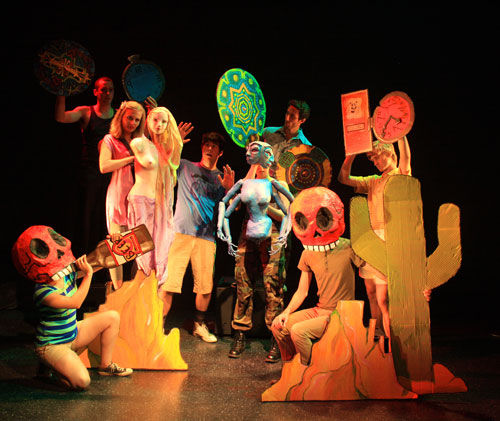
Pointless Theater
Imagine walking into a movie theater and asking to see the 7:25 p.m. showing of whatever romantic dramedy is playing that night. You give the salesperson your credit card for a ticket. As you slide the card under the glass, however, the bored teenager on the other side cracks a rare smile and asks an even rarer question: “What would you like to pay?”
Bizarre as it sounds, this business model, though not at all new (remember Radiohead’s 2007 In Rainbows?), is becoming increasingly prevalent among experimental theaters throughout the Washington area and across the country.
One group taking advantage of the model is Pointless Theatre, an emerging company founded by university alumni in summer 2009 . Its performances breach the classic separation of music, theater, dance and, most importantly, puppetry.
“Pointless Theatre is committed to creating bold visceral and affordable spectacles that completely smash the traditional boundaries between puppetry, theater, dance, music and the visual arts,” said Scott Whalen, co-director of communications and one of Pointless’ founding members.
The group is performing this weekend at Joe’s Movement Emporium in Mount Rainier and using a pay-want-you-want system. The performance and payment system are a part of the Clarice Smith Performing Arts Center’s NextLOOK series, a new initiative that provides opportunities for “young artists who don’t have the time and the space to develop new work,” said Marty Wollesen, The Clarice’s director.
“We were particularly interested in artists who were interested in having audiences be part of a critical feedback process,” Wollesen said.
The Clarice has partnered with Joe’s Movement Emporium for the 2014-15 season. A performing arts center, Joe’s provides space for 25 groups, hosts year-round arts education programs and houses a small theater for various performances, according to its artistic and executive director, Brooke Kidd. Joe’s has collaborated with The Clarice for several years, and this year, it is an integral part of the NextLOOK series.
“They have an ambitious goal of bridging audience development in Prince George’s County,” Kidd said. “[With NextLOOK], together we’re providing artists with time, space and money to work on their productions and stage them in a conversation format.”
These experimental theater groups, including Pointless, that engage audience members in a reactionary evolution are growing more prevalent throughout the Washington area. Growing with them is the trend of “pay what you can” — a payment model that invites the show attendee to pay based on the quality of what’s been presented.
The Pointless show this weekend is priced as “pay what you want” on The Clarice’s website. Audiences are free to pay as much or as little as they choose, making the performance available to audience members who otherwise wouldn’t have access.
“One of the things that [Pointless is] very dedicated to is making sure that anybody can come and see our shows. We really strive to keep our ticket prices low,” Whalen said.
With affordability and accessibility in mind, the pay-what-you-want model also functions as an unlikely tool. After a developmental piece is presented, while some theaters might hold talkback sessions to gauge audience reaction, many are relying on the attendees to quantify their enjoyment level.
dog & pony dc, an ensemble of experimental thespians, does both.
The group performed its latest project, Toast, during The Clarice’s NextNOW Fest last month. Toast, as explained on the group’s website, is a “participatory-performance-meets-science-fair”; audience members are a central part of each performance and cooperate with the actors to create a new experience with every presentation.
Toast sometimes runs in a “play-then-pay” format.
“By letting the audience set the price and letting them determine the value of the experience, we’ve continued to have them thinking about being a part of the devising process,” said Lorraine Ressegger-Slone, dog & pony dc ringleader.
Some theaters take pay-what-you-want pricing beyond audience experience and collaboration; for some, it is a mission statement.
Forum Theatre in Silver Spring is a more traditional theater company that operates via untraditional methods: audience members choose their ticket price for all performances. The group is a nonprofit that reserves 51 percent of the seats for every show. Forum’s marketing and public relations manager, Emily Wilson, believes that pay-what-you-want pricing welcomes people to take risks without wasting their money.
According to Wilson, the model is working: Forum has made more money in the last year than any other year prior, and attendance has gone up dramatically as well. Audience members have the option of paying to reserve a seat beforehand or simply arriving at the show early and taking the relatively safe gamble that a pay-what-you-want seat will be available.
For Wilson and Forum, pay-what-you-want pricing is about more than just community engagement. The trend is catching on because it changes the very aura that surrounds theater as a social institution.
“There’s kind of a new normal happening,” Wilson said.
While theater historically has been rooted very much in a wealthy white male lifestyle, Wilson continued, that won’t last forever.
“Theaters are realizing that they need to start targeting outside of that audience and that they need to be going after the next generation of their donors,” she said.



